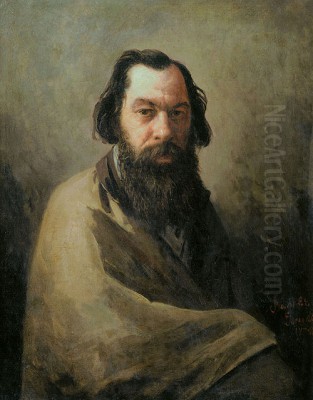
Alexei Kondratyevich Savrasov, a name synonymous with the birth of the lyrical landscape in Russian art, remains one of the most pivotal figures of 19th-century Russian painting. His profound ability to capture not just the visual likeness of the Russian countryside, but its very soul and emotional resonance, set him apart from his predecessors and contemporaries. He was an artist who saw poetry in the mundane, beauty in the thawing snow, and a deep, melancholic charm in the vast, often stark, Russian expanses. This exploration delves into the life, work, and enduring legacy of a man who taught Russia to see its own landscape with new, affectionate eyes.
Early Life and Artistic Awakening
Born on May 24, 1830, in Moscow, Alexei Savrasov hailed from a modest merchant family. From his earliest years, an undeniable passion for drawing and painting consumed him. This artistic inclination, however, was not initially supported by his father, who envisioned a more practical, commercial career for his son. Despite this familial opposition, young Alexei's talent was too potent to be suppressed. By the tender age of twelve, he was already proficiently handling watercolors and even oil paints, often selling his small pictures to local dealers to earn a pittance.
His formal artistic journey began in 1838, when, at the age of just eight, he enrolled as an irregular student at the Moscow School of Painting and Sculpture (later to include Architecture, and often referred to as MSPSA). He became a regular student in 1844. This institution was a crucible for artistic talent in Moscow, offering a slightly less rigid environment than the Imperial Academy of Arts in Saint Petersburg. Here, Savrasov's innate abilities were nurtured, particularly under the tutelage of Karl Ivanovich Rabus (born Karl Gottlieb Rabus), a respected landscape painter himself, who had studied in Germany and brought a certain Romantic sensibility to his teaching. Rabus recognized the young Savrasov's potential and encouraged his direct observation of nature.
Formative Years and Academic Recognition
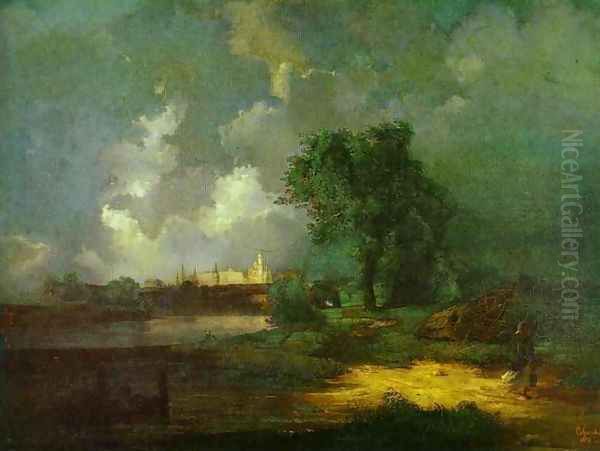
Savrasov officially graduated from the Moscow School of Painting and Sculpture in 1850, already marked as a painter of considerable promise. His early works, while still developing, showed a keen eye for detail and an emerging sensitivity to the nuances of light and atmosphere. An important trip in 1852 to the southern provinces of the Russian Empire, particularly Ukraine, proved highly influential. The vast steppes and the unique character of the southern landscapes provided him with rich material, leading to works such as View of the Kremlin from Krymsky Bridge in Inclement Weather (1851) and various steppe scenes that began to establish his reputation.
His talent did not go unnoticed by the higher echelons of the art world. In 1854, at the young age of 24, Savrasov was awarded the prestigious title of Academician by the Imperial Academy of Arts in Saint Petersburg for two paintings: View in the Neighbourhood of Oranienbaum and Seacoast in the Neighbourhood of Oranienbaum. This was a significant honor, cementing his status as a recognized master. Following this accolade, he briefly relocated to the imperial capital, Saint Petersburg, a city that was then the undisputed center of Russian artistic life, dominated by the classical traditions of the Academy.
However, Savrasov's heart and artistic spirit remained deeply connected to Moscow and the landscapes of central Russia. In 1857, he returned to Moscow to take up a teaching position at his alma mater, the Moscow School of Painting and Sculpture, where he would head the landscape painting studio for over two decades. This role allowed him to shape a new generation of Russian landscape painters.
The Birth of Lyrical Landscape
Savrasov is widely celebrated as the founder of what came to be known as the "lyrical landscape" or "mood landscape" (пейзаж настроения) in Russian art. This was a departure from the often idealized, Italianate, or grandly romantic vistas favored by the academic tradition. Instead, Savrasov sought to imbue his depictions of ordinary Russian nature with profound emotion and poetic feeling. He found beauty in the simple, often overlooked aspects of the Russian countryside: a muddy country road after a spring rain, the stark silhouettes of birch trees against a grey sky, the quiet melancholy of a village on a winter's day.
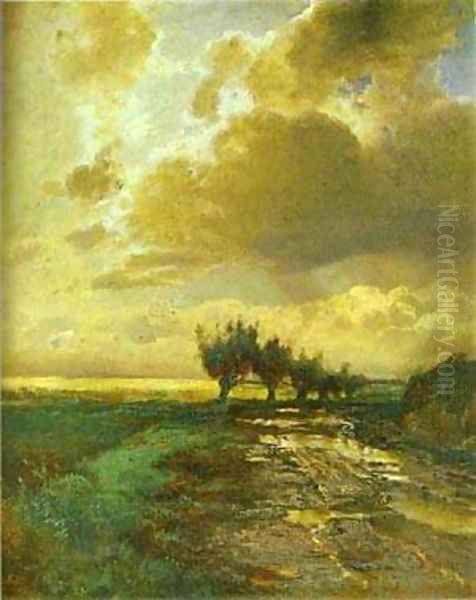
His style was characterized by a subtle yet powerful emotional charge, a deep empathy for the subject, and an ability to convey the intangible atmosphere of a place and a moment. He was less interested in topographical accuracy for its own sake than in capturing the spiritual essence of the landscape. This approach resonated deeply with a growing sense of national identity in Russia, which sought artistic expressions rooted in native soil and experience, rather than imported European conventions. Artists like Sylvester Shchedrin had earlier painted beautiful Italian landscapes, and Maxim Vorobiev had depicted grand cityscapes and dramatic natural scenes, but Savrasov's focus was more intimate and distinctly Russian.
Masterpiece: The Rooks Have Come Back
The pinnacle of Savrasov's career and the quintessential example of his lyrical landscape style is undoubtedly the painting The Rooks Have Come Back (Грачи прилетели), completed in 1871. Exhibited at the first Peredvizhniki (Wanderers) exhibition that same year, the painting was an immediate sensation and has since become an iconic image in Russian art. It depicts a seemingly unremarkable scene: the edge of a small provincial village in early spring. The snow is melting, revealing patches of damp earth. Bare, slender birch trees stand against a soft, overcast sky, their branches hosting the busy nests of rooks, the harbingers of spring. A modest wooden church with a bell tower stands in the background, and puddles of meltwater reflect the pale light.
What made this painting so revolutionary and beloved was its profound simplicity and heartfelt sincerity. Savrasov captured the subtle, almost imperceptible transition from winter to spring, a moment filled with quiet anticipation and hope. The painting is imbued with a gentle melancholy, yet also a sense of renewal and the enduring rhythm of Russian life. It was a deeply national painting, not in its subject matter of grand historical events or idealized heroes, but in its tender portrayal of the familiar Russian land. Art critic Vladimir Stasov, a champion of realist art, lauded the painting for its truthfulness and poetic insight. It was a scene every Russian could recognize and feel, a landscape of the soul.
Other Significant Works
While The Rooks Have Come Back remains his most famous work, Savrasov produced a rich body of paintings throughout his career that further exemplify his unique vision. Country Road (Просёлок, 1873) captures the muddy, rutted track so characteristic of the Russian countryside in spring or autumn, transforming a mundane subject into a poetic statement about the land and its enduring, if sometimes harsh, beauty. Moonlight over the Kremlin (1857) shows his ability to handle more traditionally romantic subjects with a unique atmospheric touch.
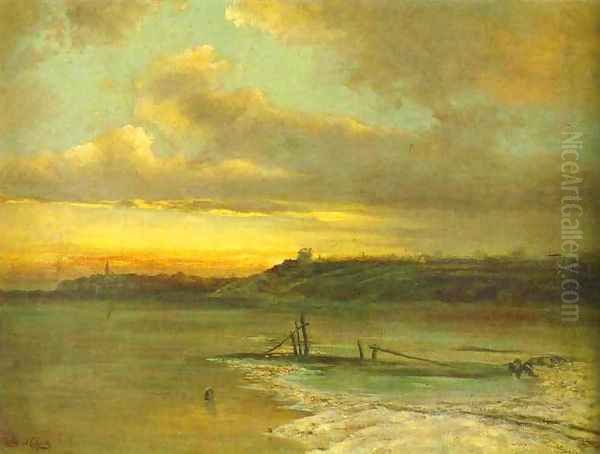
His early Ukrainian scenes, such as Steppe in Bloom (c. 1850s), demonstrated his early mastery of capturing expansive spaces and light. Winter Landscape (Thaw) (Зимний пейзаж (Оттепель), 1870s) and Early Spring. Thaw (Ранняя весна. Оттепель, 1880s) are variations on his favorite theme of nature's awakening, each rendered with delicate observation of light and atmosphere. Rainbow (Радуга, 1875) is another notable work, capturing a fleeting moment of natural beauty with his characteristic sensitivity. His paintings often featured humble rural architecture, quiet rivers, and the ever-present birch trees, all rendered with a deep understanding of their place within the Russian psyche.
Travels and European Influences
Like many Russian artists of his time, Savrasov undertook travels to Europe, which broadened his artistic horizons. In 1862, he journeyed to England to see the International Exhibition in London, and also visited Switzerland, France, and Germany. During these travels, he was particularly impressed by the works of the English landscape painter John Constable, whose commitment to capturing the natural effects of light and atmosphere in his native Suffolk countryside resonated with Savrasov's own artistic inclinations. He also admired the Swiss Alpine painter Alexandre Calame, known for his majestic mountain scenes, though Savrasov's own temperament leaned towards more intimate and less dramatic landscapes.
These European experiences likely reinforced his belief in the importance of direct observation and the portrayal of one's native landscape with truthfulness and feeling. However, unlike some of his contemporaries who might have adopted more overtly European styles, Savrasov absorbed these influences and integrated them into his distinctly Russian artistic vision. His exposure to international art did not dilute his national voice but rather refined his means of expressing it.
The Peredvizhniki Movement
Savrasov was a founding member of one of the most significant artistic movements in Russian history: the "Society for Traveling Art Exhibitions" (Товарищество передвижных художественных выставок), commonly known as the Peredvizhniki or the Wanderers. Established in 1870, this group rebelled against the conservative, academic art establishment centered in Saint Petersburg. The Peredvizhniki aimed to create a truly national Russian art, rooted in realism and often addressing social issues and the lives of ordinary people. They sought to make art accessible to a wider public by organizing traveling exhibitions throughout the provinces.
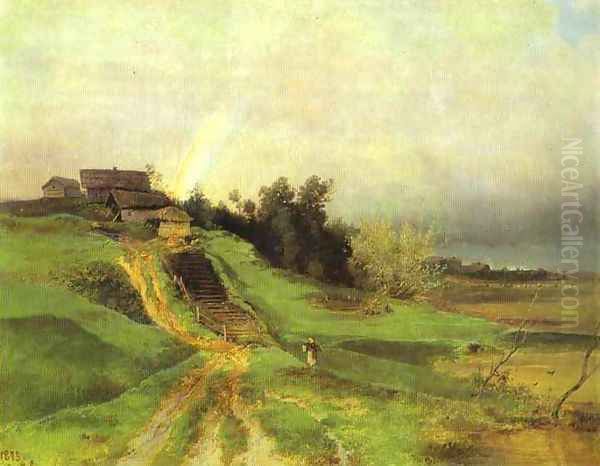
Key figures in the Peredvizhniki movement included Ivan Kramskoi, its intellectual leader, genre painters like Vasily Perov (a close friend of Savrasov, with whom he sometimes collaborated or depicted in his works), historical painters such as Vasily Surikov and Ilya Repin, and fellow landscape painters like Ivan Shishkin, known for his detailed and epic forest scenes, and Arkhip Kuindzhi, celebrated for his dramatic effects of light. Savrasov's participation was crucial, as he brought the genre of landscape painting to the forefront of this new realist and nationalist art. His The Rooks Have Come Back was a highlight of their very first exhibition in 1871, perfectly embodying the movement's ideals of truthfulness to Russian life and nature.
Teaching and Influence on a New Generation
From 1857 to 1882, Alexei Savrasov served as a professor and head of the landscape studio at the Moscow School of Painting and Sculpture. He was a dedicated and influential teacher, inspiring a generation of artists who would further develop Russian landscape painting. His teaching methods emphasized direct observation of nature, encouraging students to work en plein air (outdoors) and to seek the poetic essence of their surroundings. He urged them to find beauty in the familiar and to express their personal emotional responses to the landscape.
Among his most notable students were Isaac Levitan and Konstantin Korovin. Levitan, in particular, is considered Savrasov's spiritual successor, developing the "mood landscape" to new heights of poetic expression and psychological depth. Levitan always spoke of his teacher with immense respect and gratitude, acknowledging the profound impact Savrasov had on his artistic development. Korovin, while later becoming a leading figure of Russian Impressionism, also benefited from Savrasov's emphasis on capturing light and atmosphere. Other students included Mikhail Nesterov, known for his deeply spiritual paintings often set in evocative landscapes, and Sergey Svetoslavsky. Savrasov's legacy as an educator is thus as significant as his own artistic output.
Personal Tragedies and Later Years
Despite his artistic successes and his influential teaching career, Savrasov's personal life was marked by profound tragedy and hardship, particularly in his later years. He experienced the devastating loss of several children in infancy, including his daughter in the early 1870s, which deeply affected him and is believed to have contributed to a growing melancholy in his work and life. His marriage to Sophia Karlovna Hertz, sister of art historian Karl Hertz, eventually broke down.
These personal sorrows, coupled with a sensitive and perhaps vulnerable temperament, led Savrasov to struggle with alcoholism. This addiction increasingly took a toll on his health, his ability to work consistently, and his professional standing. In 1882, he was dismissed from his teaching position at the Moscow School of Painting and Sculpture due to his deteriorating condition and irregular attendance.

The last fifteen years of his life were characterized by poverty, declining health, and increasing isolation. Though he continued to paint, his output became uneven, and he often struggled to find buyers. He was sometimes seen wandering the streets of Moscow, a shadow of his former self, occasionally selling small sketches for meager sums. Despite these hardships, moments of his former brilliance would still surface in his work. In 1894, a collection of his drawings was published, marking a half-century of his artistic endeavors, a poignant reminder of his enduring talent. His friend Vasily Perov had passed away in 1882, and other contemporaries like Nikolai Ge and Ivan Kramskoi were also aging or had passed, leaving him increasingly alone.
Enduring Legacy
Alexei Kondratyevich Savrasov passed away on October 8 (September 26, Old Style), 1897, in a Moscow hospital for the poor. He was buried in the Vagankovskoye Cemetery. While his final years were tragic, his contribution to Russian art is indelible. He fundamentally changed the course of Russian landscape painting, shifting its focus from idealized or foreign scenes to an intimate, heartfelt portrayal of the native Russian land.
His "lyrical landscape" opened up new expressive possibilities for the genre, demonstrating that profound emotion and national identity could be found in the simplest of motifs. He taught generations of artists, both directly as a professor and indirectly through the power of his work, to look at their own environment with fresh eyes and to find poetry in the everyday. Artists like Isaac Levitan, Konstantin Korovin, Valentin Serov (though more a portraitist, he also painted landscapes), and even earlier figures like Fyodor Vasilyev, who died young but showed immense promise in landscape, all operated in a world shaped by Savrasov's innovations. His influence extended beyond landscape specialists; even history painters like Vasily Surikov or genre painters like Vladimir Makovsky understood the importance of the authentic Russian setting that Savrasov championed.
Conclusion
Alexei Savrasov's art is a testament to the power of quiet observation and sincere emotion. He was more than just a painter of places; he was a poet of the Russian soul as reflected in its landscape. His masterpiece, The Rooks Have Come Back, remains a beloved symbol of spring, hope, and Russian identity. Despite the personal adversities he faced, Savrasov left behind a legacy that continues to resonate. He gave Russian art its own distinctive landscape voice, one that was lyrical, melancholic, and profoundly beautiful, ensuring his place among the giants of Russian culture, alongside artists like Karl Bryullov, who captured grand historical moments, or Pavel Fedotov, who pioneered critical realism in genre painting. Savrasov's contribution was to find the epic in the intimate, the universal in the specifically Russian.